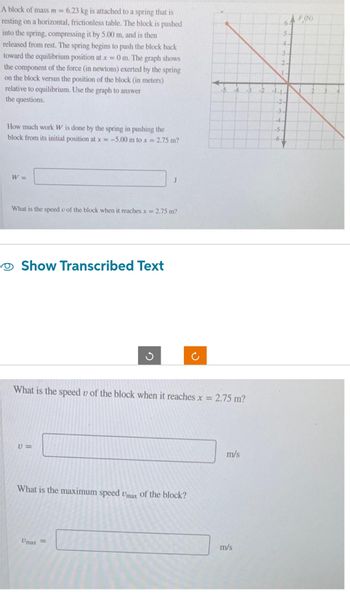
Principles of Physics: A Calculus-Based Text
5th Edition
ISBN: 9781133104261
Author: Raymond A. Serway, John W. Jewett
Publisher: Cengage Learning
expand_more
expand_more
format_list_bulleted
Question
Don't use chat gpt It

Transcribed Image Text:A block of mass m = 6.23 kg is attached to a spring that is
resting on a horizontal, frictionless table. The block is pushed
into the spring, compressing it by 5.00 m, and is then
released from rest. The spring begins to push the block back
toward the equilibrium position at x = 0 m. The graph shows
the component of the force (in newtons) exerted by the spring
on the block versus the position of the block (in meters)
relative to equilibrium. Use the graph to answer
the questions.
How much work W is done by the spring in pushing the
block from its initial position at x=-5.00 m to x = 2.75 m?
64 F(N)
5
4-
3
2
L
-1-1-
-2-
-3-
4-
-5.
-6-
W=
J
What is the speed u of the block when it reaches x = 2.75 m?
• Show Transcribed Text
ง
୯
What is the speed of the block when it reaches x =
10=
What is the maximum speed Umax of the block?
Umax
=
2.75 m?
m/s
m/s

Expert Solution
This question has been solved!
Explore an expertly crafted, step-by-step solution for a thorough understanding of key concepts.
Step by stepSolved in 2 steps with 5 images

Knowledge Booster
Similar questions
- A 1.00-kg object slides to the right on a surface having a coefficient of kinetic friction 0.250 (Fig. P7.68a). The object has a speed of vi = 3.00 m/s when it makes contact with a light spring (Fig. P7.68b) that has a force constant of 50.0 N/m. The object comes to rest after the spring has been compressed a distance d (Fig. P7.68c). The object is then forced toward the left by the spring (Fig. P7.68d) and continues to move in that direction beyond the springs unstretched position. Finally, the object comes to rest a distance D to the left of the unstretched spring (Fig. P7.68e). Find (a) the distance of compression d, (b) the speed v at the unstretched position when the object is moving to the left (Fig. P7.68d), and (c) the distance D where the object comes to rest. Figure P7.68arrow_forwardAssume that the force of a bow on an arrow behaves like the spring force. In aiming the arrow, an archer pulls the bow back 50 cm and holds it in position with a force of 150 N. If the mass of the arrow is 50 g and the “spring” is massless, what is the speed of the arrow immediately after it leaves the bow?arrow_forwardA student working on a school project modeled a trampoline as a spring obeying Hookes law and measured the spring constant of a certain trampoline as 4617 N/m. If a child of mass 27.0 kg compresses the trampoline vertically by a maximum of 0.25 m, while bouncing up and down, what is the childs acceleration at the moment of maximum compression?arrow_forward
- A 1.00-kg object slides to the right on a surface having a coefficient of kinetic friction 0.250 (Fig. P8.62a). The object has a speed of vi = 3.00 m/s when it makes contact with a light spring (Fig. P8.62b) that has a force constant of 50.0 N/m. The object comes to rest after the spring has been compressed a distance d (Fig. P8.62c). The object is then forced toward the left by the spring (Fig. P8.62d) and continues to move in that direction beyond the spring's unstretched position. Finally, the object comes to rest a distance D to the left of the unstretched spring (Fig. P8.62e). Find (a) the distance of compression d, (b) the speed vat the unstretched posi-tion when the object is moving to the left (Fig. P8.624), and (c) the distance D where the abject comes to rest. Figure P8.62arrow_forwardA 6 000-kg freight car rolls along rails with negligible friction. The car is brought to rest by a combination of two coiled springs as illustrated in Figure P6.27 (page 188). Both springs are described by Hookes law and have spring constants k1 = 1 600 N/m and k2, = 3 400 N/m. After the first spring compresses a distance of 30.0 cm, the second spring acts with the first to increase the force as additional compression occurs as shown in the graph. The car comes to rest 50.0 cm after first contacting the two-spring system. Find the cars initial speed.arrow_forwardA block of mass 0.250 kg is placed on top of a light, vertical spring of force constant 5 000 N/m and pushed downward so that the spring is compressed by 0.100 m. After the block is released from rest, it travels upward and then leaves the spring. To what maximum height above the point of release does it rise?arrow_forward
- If the net work done by external forces on a particle is zero, which of the following statements about the particle must be true? (a) Its velocity is zero. (b) Its velocity is decreased. (c) Its velocity is unchanged. (d) Its speed is unchanged. (e) More information is needed.arrow_forwardA toy cannon uses a spring to project a 5.30-g soft rubber ball. The spring is originally compressed by 5.00 cm and has a force constant of 8.00 N/m. When the cannon is fired, the ball moves 15.0 cm through the horizontal barrel of the cannon, and the barrel exerts a constant friction force of 0.032 0 N on the ball. (a) With what speed does the projectile leave the barrel of the cannon? (b) At what point does the hall have maximum speed? (c) What is this maximum speed?arrow_forwardWhy is the following situation impossible? In a new casino, a supersized pinball machine is introduced. Casino advertising boasts that a professional basketball player can lie on top of the machine and his head and feet will not hang off the edge! The hall launcher in the machine sends metal halls up one side of the machine and then into play. The spring in the launcher (Fig. P7.44) has a force constant of 1.20 N/cm. The surface on which the ball moves is inclined = 10.0 with respect to the horizontal. The spring is initially compressed its maximum distance d = 5.00 cm. A ball of mass 100 g is projected into play by releasing the plunger. Casino visitors find the play of the giant machine quite exciting. Figure P7.44arrow_forward
- Why is the following situation impossible? In a new casino, a supersized pinball machine is introduced. Casino advertising boasts that a professional basketball player can lie on top of the machine and his head and feet will not hang off the edge! The ball launcher in the machine sends metal balls up one side of the machine and then into play. The spring in the launcher (Fig. P6.60) has a force constant of 1.20 N/cm. The surface on which the ball moves is inclined = 10.0 with respect to the horizontal. The spring is initially compressed its maximum distance d = 5.00 cm. A ball of mass 100 g is projected into play by releasing the plunger. Casino visitors find the play of the giant machine quite exciting.arrow_forwardAn athlete jumping vertically on a trampoline leaves the surface with a velocity of 8.5 m/s upward. What maximum height does she reach? (a) 13 m (b) 2.3 m (c) 3.7 m (d) 0.27 m (e) The answer cant be determined because the mass of the athlete isnt given.arrow_forwardReview. A 3.00-kg block starts from rest at the top of a 30.0 incline and slides a distance of 2.00 m down the incline in 1.50 s. Find (a) the magnitude of the acceleration of the block, (b) the coefficient of kinetic friction between block and plane, (c) the friction force acting on the block, and (d) the speed of the block after it has slid 2.00 m.arrow_forward
arrow_back_ios
SEE MORE QUESTIONS
arrow_forward_ios
Recommended textbooks for you
 Principles of Physics: A Calculus-Based TextPhysicsISBN:9781133104261Author:Raymond A. Serway, John W. JewettPublisher:Cengage Learning
Principles of Physics: A Calculus-Based TextPhysicsISBN:9781133104261Author:Raymond A. Serway, John W. JewettPublisher:Cengage Learning University Physics Volume 1PhysicsISBN:9781938168277Author:William Moebs, Samuel J. Ling, Jeff SannyPublisher:OpenStax - Rice University
University Physics Volume 1PhysicsISBN:9781938168277Author:William Moebs, Samuel J. Ling, Jeff SannyPublisher:OpenStax - Rice University Physics for Scientists and Engineers: Foundations...PhysicsISBN:9781133939146Author:Katz, Debora M.Publisher:Cengage Learning
Physics for Scientists and Engineers: Foundations...PhysicsISBN:9781133939146Author:Katz, Debora M.Publisher:Cengage Learning Physics for Scientists and Engineers, Technology ...PhysicsISBN:9781305116399Author:Raymond A. Serway, John W. JewettPublisher:Cengage Learning
Physics for Scientists and Engineers, Technology ...PhysicsISBN:9781305116399Author:Raymond A. Serway, John W. JewettPublisher:Cengage Learning Classical Dynamics of Particles and SystemsPhysicsISBN:9780534408961Author:Stephen T. Thornton, Jerry B. MarionPublisher:Cengage Learning
Classical Dynamics of Particles and SystemsPhysicsISBN:9780534408961Author:Stephen T. Thornton, Jerry B. MarionPublisher:Cengage Learning Physics for Scientists and Engineers with Modern ...PhysicsISBN:9781337553292Author:Raymond A. Serway, John W. JewettPublisher:Cengage Learning
Physics for Scientists and Engineers with Modern ...PhysicsISBN:9781337553292Author:Raymond A. Serway, John W. JewettPublisher:Cengage Learning

Principles of Physics: A Calculus-Based Text
Physics
ISBN:9781133104261
Author:Raymond A. Serway, John W. Jewett
Publisher:Cengage Learning

University Physics Volume 1
Physics
ISBN:9781938168277
Author:William Moebs, Samuel J. Ling, Jeff Sanny
Publisher:OpenStax - Rice University

Physics for Scientists and Engineers: Foundations...
Physics
ISBN:9781133939146
Author:Katz, Debora M.
Publisher:Cengage Learning

Physics for Scientists and Engineers, Technology ...
Physics
ISBN:9781305116399
Author:Raymond A. Serway, John W. Jewett
Publisher:Cengage Learning

Classical Dynamics of Particles and Systems
Physics
ISBN:9780534408961
Author:Stephen T. Thornton, Jerry B. Marion
Publisher:Cengage Learning

Physics for Scientists and Engineers with Modern ...
Physics
ISBN:9781337553292
Author:Raymond A. Serway, John W. Jewett
Publisher:Cengage Learning